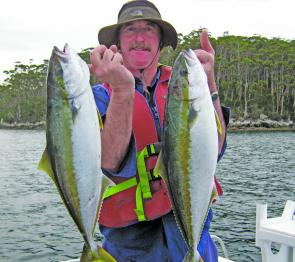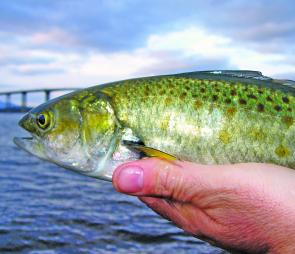More rain has kept the Derwent bream from firing up and has also interrupted the feeding patterns for both resident and sea trout.
Luckily there have been other options on the saltwater front as cray season kicked off for the year and the warmer days also encouraged many to test the nearby inshore and bay fishing. Fly anglers in particular will be looking forward to some spectacular hatches brought on by the humid conditions that the recent weather patterns are generating.
It may take a while for the freshwater scene to settle this year but when it does the Derwent Valley streams should experience some awesome hopper action. Our local rivers should be alive with a bumper crop of hoppers and the aggressively feeding trout that look to feed on this feast. Don’t miss out this month.
The Derwent bream scene has had a patchy month or so, as more rain has generally kept a lid on any consistent bite. This is not a bad result for the fishery as bream are attempting to spawn.
We should now see some much more dependable weather as January presents local breamers with much better opportunities and increased activity from the post spawn fish. Prospecting the shallows with hardbodied lures now becomes the standard approach as bream filter downstream looking to feed up and regain some condition.
Slim profile minnows in the 4-7cm size range are ideal lures for working the shallower areas. Try the Ecogear MW and MX series and Rapala X-Raps in olive, green or other natural base colours with a touch of silver, yellow or orange as an attractor.
As per usual, the mid reaches of the Derwent is often the best zone to focus on when looking to find active bream in January. Any of the rocky points and ledges throughout Elwick Bay are worth targeting this month. If you can find a bream or two there will just about always be a few more in the general area.
If the bream don’t seem to be up in the shallows then try a slightly deeper running lure along the outer edges of the shallow sections or against steeper banks. Try the Ecogear SX range for fishing these areas and keep an eye out for the new Ecogear CX40HS deep diver as these new models will get down to 2m easily on light 4lb leader. Sinking lures, blades and soft plastics are still an option when fishing to deeper holding bream, especially around pylons and bridges.
Looking back to last summer, this month is when the yellowtail kingfish arrived in numbers and is also when the first reports of good bags surfaced. A couple of recent captures in Frederick Henry Bay are a good sign of things to come. These fish were typical of the specimens that were about last summer weighing in at around 2-3kg.
Several bays around the Tasman Peninsula had periods of good fishing for kingies last year and I wouldn’t expect this season to be any different. Trolling minnow lures in conjunction with large stickbait style plastics is a successful method of finding these fish.
Look for bait congregations while trolling and then fish at differing depths near the bait schools once they are located. This can be done with heavier rigged soft stickbaits between 5”-7” and also with smaller knife jig style lures or even plain old slice type metal lures.
If you are lucky enough to find the kingies, be sure to have other rods at the ready as more fish often hold behind one that is hooked. Casting behind or dropping below the hooked fish often results in another hook up and the action then flows. If you do hear of captures and are looking to latch onto your first kingfish then it’s important to act immediately, not two weeks later. My advice would be to get ready now and strike while the schools are in a defined area.
Some basic rigs are 5”-7” Berkley or Slam stickbaits rigged on Squidgy Fish Head jigs in 3/0-6/0 1/2oz weight for a trolling skip bait or 3/4oz to 1oz for jigging. Try 100-140mm diving minnow lures when trolling and searching for schools or Halco Gold Twistys in 40-50g as an all-round casting/jig lure.
Rods around 7’ long and in the 3-6kg or 4-8kg rating are a good choice for presenting these types of lures. You will need a decent quality braid capable reel usually in the 4000 size range and loaded with 15-20lb braid for best results.
Water temperatures are on a steady increase and the arrival of decent amounts of albacore should not be far away. Mako shark enthusiasts have had success since late November and there should still be enough out there to interest those keen enough to put in the hours necessary to snare one.
For the bay fishers there will be plenty of good flathead and calamari available this summer as there have been good size and numbers in catches during spring. Calamari in particular have been quite large and quite a challenge on light gear.
I had to chase one with the electric motor on a recent trip down to Opossum Bay. Try using some quality jigs from Fish League, Yamashita and Yo-Zuri when the squid are fussy.
To end on a high note, local trout fishers will be pleased to hear that Craigbourne Dam has received a new delivery of 1kg rainbow trout to add to the options on offer for Hobart freshwater anglers. Looks like it’s going to be a busy month…
Reads: 2685
Massive calamari are an option, but use good jigs, as the expensive ones are well worth the price.

Yellowtail kingfish have arrived – most are 2-3kg like these fish.

Bream are spreading out again after spawning – look for the shallow water and use good quality hardbodied lures.

Australian salmon are a reliable standby when all else fails, or if you want some easy fish for the family.




